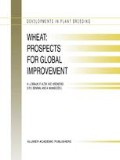Summary
Tributes to wheat and its contribution to agriculture and humanity over the centuries can be found on carvings on utensils, pictographs from early civilizations, and in many religious writings. The Food and Agriculture Organization of the United Nations selected as their emblem a spike of wheat rising above the Latin inscription Fiat Panis (‘Let there be bread’).
With the development of high yield cultivars which respond to improved management practices, wheat production has increased over 100million metric tons (mmt) per decade since the 1960s.Many examples can be cited to support the importance of genetic diversity and the role it has played in the improvement of wheat. Historically, the worldwide community of breeders have freely shared their genetic materials and depended on others for the development of contemporary cultivars. Any constraints which reduce the availability of genetic resources must be viewed with alarm. Genetic erosion, collection, preserving and maintaining the genetic integrity of existing germplasm collections, and factors which influence the free exchange of germplasm can all have a detrimental impact on future wheat improvement. Breeders and other public and private decision makers all must share a responsibility and an obligation to insure that future breeders will have the necessary genetic variability if wheat is going to continue to be a major contributor to world food production. Based on expected population growth and an increasing preference for wheat products, especially in developing countries, wheat will be even more important in the next century if an increasingly hungry population is to be fed.
Access this chapter
Tax calculation will be finalised at checkout
Purchases are for personal use only
Preview
Unable to display preview. Download preview PDF.
References
Borlaug, NE & C.R. Dowswell, 1996. The acid lands: One of agriculture’s last frontiers. In: Proceedings of the 4th International Symposium on Plant-Soil Interactions at Low pH. Belo Horizonte, Brazil.
Burton, G.W., 1966. Prospects for the Future. In: Fry (Ed.), International Plant Breeding Symposium., pp. 391–406. Iowa State University Press.
CIMMYT, 1995. CIMMYT World Wheat Facts and Trends Supplement. Ongoing Research at CIMMYT: Understanding wheat genetic diversity and international flows of genetic resources. CIMMYT, Mexico, D.F., Mexico.
Cook, R.J. & R.J. Veseth, 1992. Wheat Health Management. APS Press, St. Paul, USA.
Evans, LT, 1986. Opportunities for increasing the yield potential of wheat, pp. 1–19. CSIRO Division of Plant Industry. Canberra, ACT, Australia.
Firat, A.E. & A. Tan, 1995. Turkey maintains pivotal role in global genetic resources. D. Strauss (Ed.), Diversity 11(162): 61–63.
Hansen, H., NE Borlaug & R.G. Anderson, 1982. Wheat in the third world. IADS Development Oriental Literature Series. Westview Press, Boulder, Colorado, USA.
Harlan, J.R., 1975. Our vanishing genetic resources. Science 188: 618–621.
Oleson, B.T., 1994. World wheat production, utilization, and trade. In: W. Bushek & Rosper (Eds.), International wheat production, properties and quality., pp. 1–10.
Petrucci, S., 1995. The wonders of wheat. International World Bank News. External Affairs Department, Washington, DC.
Raeburn, P., 1995. The Last Harvest: The genetic gamble that threatens to destroy American agriculture, pp. 269. Simon and Schuster, New York.
Schmidt, J.W., V.A. Johnson & S.S. Maan, 1962. Hybrid wheat. Nebr Exp Sta Quart 9(1):9.
Author information
Authors and Affiliations
Editor information
Editors and Affiliations
Rights and permissions
Copyright information
© 1997 Springer Science+Business Media Dordrecht
About this chapter
Cite this chapter
Kronstad, W.E. (1997). Agricultural development and wheat breeding in the 20th Century. In: Braun, HJ., Altay, F., Kronstad, W.E., Beniwal, S.P.S., McNab, A. (eds) Wheat: Prospects for Global Improvement. Developments in Plant Breeding, vol 6. Springer, Dordrecht. https://doi.org/10.1007/978-94-011-4896-2_1
Download citation
DOI: https://doi.org/10.1007/978-94-011-4896-2_1
Publisher Name: Springer, Dordrecht
Print ISBN: 978-94-010-6053-0
Online ISBN: 978-94-011-4896-2
eBook Packages: Springer Book Archive

